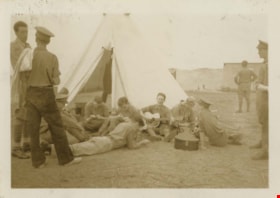More like 'Speed Watch at Wesburn Park'
Narrow Results By
Decade
- 2020s 93
- 2010s 44
- 2000s 66
- 1990s 176
- 1980s 82
- 1970s 325
- 1960s 77
- 1950s 131
- 1940s 145
- 1930s 166
- 1920s 122
- 1910s 49
- 1900s 35
- 1890s 6
- 1880s 1
- 1870s 2
- 1860s 1
- 1850s 1
- 1840s 1
- 1830s 2
- 1820s 1
- 1810s 1
- 1800s 1
- 1790s 1
- 1780s 1
- 1770s 1
- 1760s 1
- 1750s 1
- 1740s 1
- 1730s 1
- 1720s 1
- 1710s 1
- 1700s 1
- 1690s 1
- 1680s 1
- 1670s 1
- 1660s 1
- 1650s 1
- 1640s 1
- 1630s 1
- 1620s 1
- 1610s 1
- 1600s 1
Subject
- Adornment 5
- Adornment - Jewelry 1
- Adornment - Lapel Pins 3
- Advertising Medium 16
- Advertising Medium - Poster 1
- Advertising Medium - Signs and Signboards 36
- Aerial Photographs 1
- Agricultural Tools and Equipment 3
- Agricultural Tools and Equipment - Gardening Equipment 1
- Agriculture 9
- Agriculture - Crops 3
- Agriculture - Farms 32
nunchuks
https://search.heritageburnaby.ca/link/museumartifact37082
- Repository
- Burnaby Village Museum
- Accession Code
- BV991.45.524
- Description
- These nuchuks are a prisoner made weapon confiscated by guards. Based on an Oriental weapon, popular in the marshal arts. Short lengths of wood are connected by a chain ( the chain is broken ).
- Object History
- Salvaged from Oakalla Prison site, October, 1991.
Images
razor wire
https://search.heritageburnaby.ca/link/museumartifact34385
- Repository
- Burnaby Village Museum
- Accession Code
- BV991.45.273
- Description
- A piece of galvanized steel razor wire made up of a convex strand with 5 double edged blades protruding at equal lengths from each other. Markings are not visible.
- Object History
- Salvaged from Oakalla Prison Farm site in October 1991. This artifact was found by the Women's and Stores buildings.
- Measurements
- Overall measurements: Length: 41.8 cm Width: 18.6 cm Thickness: 1 cm
Images
razor wire
https://search.heritageburnaby.ca/link/museumartifact34386
- Repository
- Burnaby Village Museum
- Accession Code
- BV991.45.274
- Description
- A piece of galvanized steel razor wire with a circular strand in the middle from which protrude 22 pairs of blades.
- Object History
- Salvaged from Oakalla Prison Farm site in October 1991. This artifact was found by the Women's and Stores buildings.
- Measurements
- Overall measurements: Length: 53.6 cm Width: 6.2 cm Thickness: 1.1 cm
Images
rubber bullet cartridge casing
https://search.heritageburnaby.ca/link/museumartifact34208
- Repository
- Burnaby Village Museum
- Accession Code
- BV991.45.95
- Description
- Cartridge for shooting gas gun.
- Object History
- Salvaged from Oakalla Prison site in October 1991
- Marks/Labels
- "203 CN Federal Muzzle Dispersion Cartridge, Chemical Agent (CN) Warning...Danger. for use by trained personnel only"
- Names
- Oakalla Prison Farm
Images
rubber stamp
https://search.heritageburnaby.ca/link/museumartifact34166
- Repository
- Burnaby Village Museum
- Accession Code
- BV991.45.53
- Description
- Stamp, rubber, with handle
- Object History
- Salvaged from Oakalla Prison site in October 1991
- Marks/Labels
- "East Wing"
- Names
- Oakalla Prison Farm
Images
rubber stamp
https://search.heritageburnaby.ca/link/museumartifact34168
- Repository
- Burnaby Village Museum
- Accession Code
- BV991.45.55
- Description
- Stamp, rubber, with handle; `B.C. Stamp Works, Vancouver, 687-6971'
- Object History
- Salvaged from Oakalla Prison site in October 1991
- Marks/Labels
- "L.M.R.C.C. East Wing. Remission. Awarded... Days. Review Comm."
- Names
- Oakalla Prison Farm
Images
ruler
https://search.heritageburnaby.ca/link/museumartifact34397
- Repository
- Burnaby Village Museum
- Accession Code
- BV991.45.285
- Description
- 12 inch, wooden ruler made by the Acme Co. of Canada. Marked in inches on one side and centimeters on the opposite side. Written on the centimeter side with black felt marker is, "Baitz 1 800 I Escape"; Both ends and top edge of the ruler have been stained with ink. There are small gouges at one end.
- Object History
- Salvaged from Oakalla Prison Farm site in October 1991
- Marks/Labels
- "Acme Made in Canada" printed on inch side of ruler. "Baitz 1 800 I Escape", written in felt pen on centimeter side of ruler. Face of ruller marked out in inches up to 12 Reverse of ruler marked out in centimeters up to 30.
- Subjects
- Public Services
- Public Services - Correctional
- Weights and Measurements Tools and Equipment
Images
shiv
https://search.heritageburnaby.ca/link/museumartifact37086
- Repository
- Burnaby Village Museum
- Accession Code
- BV991.45.528
- Description
- This is a prisoner made weapon, confiscated by guards at Oakalla prison. The weapon is made from a short, round wood dowel, with a sharpened nail projecting from one end.
- Object History
- Salvaged from Oakalla Prison site, October, 1991.
Images
shiv
https://search.heritageburnaby.ca/link/museumartifact37087
- Repository
- Burnaby Village Museum
- Accession Code
- BV991.45.529
- Description
- This is a prisoner made weapon, confiscated by guards at Oakalla prison. The weapon is made from a short, round wood dowel, with a sharpened nail projecting from one end.
- Object History
- Salvaged from Oakalla Prison site, October, 1991.
Images
shiv
https://search.heritageburnaby.ca/link/museumartifact37088
- Repository
- Burnaby Village Museum
- Accession Code
- BV991.45.530
- Description
- This is a prisoner made weapon confiscated by the guards at Oakalla prison. It is made from a car antenna with masking tape wound around one end to use as the handle.
- Object History
- Salvaged from Oakalla Prison site, October, 1991.
Images
shiv
https://search.heritageburnaby.ca/link/museumartifact37089
- Repository
- Burnaby Village Museum
- Accession Code
- BV991.45.531
- Description
- This is a prisoner made weapon confiscated by the guards at Oakalla prison. The blade is made from a short length of steel bar stock. It is sharpened at one end and has masking tape wrapped around the other end.
- Object History
- Salvaged from Oakalla Prison site, October, 1991.
Images
shiv
https://search.heritageburnaby.ca/link/museumartifact37092
- Repository
- Burnaby Village Museum
- Accession Code
- BV991.45.534
- Description
- This weapon is made from a short length of steel bar stock. It has been pointed and sharpened at one end. Two holes have been drilled at the other end.
- Object History
- Salvaged from Oakalla Prison site, October, 1991.
- Maker
- Unknown
- Country Made
- Canada
- Province Made
- British Columbia
- Site/City Made
- Oakalla Prison
Images
shiv
https://search.heritageburnaby.ca/link/museumartifact37094
- Repository
- Burnaby Village Museum
- Accession Code
- BV991.45.536
- Description
- This is a prisoner made weapon confiscated by the guards at Oakalla prison. A plastic pen casing has been forced over a nail. The ends of the pen have been melted to secure it to the nail.
- Object History
- Salvaged from Oakalla Prison site, October, 1991.
- Marks/Labels
- "PA_______", printed on the side of the pen casing.
- Maker
- Unknown
- Country Made
- Canada
- Province Made
- British Columbia
- Site/City Made
- Oakalla Prison
Images
shiv
https://search.heritageburnaby.ca/link/museumartifact40175
- Repository
- Burnaby Village Museum
- Accession Code
- BV991.45.545
- Description
- This is a prisoner made weapon that was confiscated by the guards at Oakalla prison. The shiv is made from the plastic handle of a tooth brush, dark grey in colour. The handle has a hole on end for hanging the toothbrush. A short metal blade has been heated and forced into the end of the plastic handle.
- Object History
- Salvaged from Oakalla Prison site, October, 1991.
- Marks/Labels
- "U.S.A." / "#411 G.U.M." / registered' symbol / "Velvet-Tip" / "by Butler", printed in gold on toothbrush handle
- Maker
- Unknown
- Country Made
- Canada
- Province Made
- British Columbia
- Site/City Made
- Oakalla Prison
Images
tear gas grenade
https://search.heritageburnaby.ca/link/museumartifact34207
- Repository
- Burnaby Village Museum
- Accession Code
- BV991.45.94
- Description
- Tear gas grenade
- Object History
- Salvaged from Oakalla Prison site in October 1991
- Marks/Labels
- "240 Practise Grenade, Federal Laboratories Inc., Salts- burg, Pennsylvania"
- Names
- Oakalla Prison Farm
Images
zap
https://search.heritageburnaby.ca/link/museumartifact36539
- Repository
- Burnaby Village Museum
- Accession Code
- BV995.2.1
- Description
- Zap, also known as a blackjack. Short, black, rubber club.
- Object History
- Object was used at Oakalla Prison Farm and was obtained after the prison closed in 1991.
Images
Prisons & Reformatories in Early Burnaby
https://search.heritageburnaby.ca/link/museumdescription14759
- Repository
- Burnaby Village Museum
- Date
- 15 Oct. 2020
- Collection/Fonds
- Burnaby Village Museum fonds
- Description Level
- Item
- Physical Description
- 1 video recording (mp4) (60 min., 53 sec.) : digital, col., sd., stereo ; 29 fps
- Scope and Content
- Item consists of a video recording of a live Zoom webinar hosted by Burnaby Village Museum's Kate Petrusa. The webinar is titled "Prisons & Reformatories in Early Burnaby" and is presented by Lisa Codd, Heritage Planner for the City of Burnaby. The zoom webinar is the fourth in a collection of seve…
- Repository
- Burnaby Village Museum
- Collection/Fonds
- Burnaby Village Museum fonds
- Description Level
- Item
- Physical Description
- 1 video recording (mp4) (60 min., 53 sec.) : digital, col., sd., stereo ; 29 fps
- Material Details
- Presenter: Lisa Codd
- Host: Kate Petrusa
- Date of Presentation: October 15, 6:00 pm - 8:00 pm
- Total Number of tracks: 1
- Total Length of all tracks:60 min., 53 sec
- Recording Device: Zoom video communication platform
- Scope and Content
- Item consists of a video recording of a live Zoom webinar hosted by Burnaby Village Museum's Kate Petrusa. The webinar is titled "Prisons & Reformatories in Early Burnaby" and is presented by Lisa Codd, Heritage Planner for the City of Burnaby. The zoom webinar is the fourth in a collection of seven "Burnaby Neighbourhood Speaker series" webinars that were presented and made available to the public between September 29 and October 27, 2020. The live webinar and recording was also made available on the Burnaby Village Museum's facebook page. In this webinar, Lisa Codd talks about how in the early 20th century Burnaby was home to several correctional and detention institutions that sought to reform their residents, including the Oakalla Prison Farm, New Haven Borstal Home for Boys and Youthful Offenders, the United Church Home for Girls and Home of the Friendless. Lisa supports her presentation with contemporary and historical photographs and research. Lisa pauses throughout the presentation to take questions from webinar participants.
- Creator
- Burnaby Village Museum
- Subjects
- Persons - Japanese Canadians
- Indigenous peoples - British Columbia
- Public Services - Correctional
- Names
- Codd, Lisa
- Oakalla Prison Farm
- New Haven Correctional Centre
- Lower Mainland Regional Correctional Centre
- George, Richardson
- George, Eneas
- George, Alex
- George, Joseph
- Peltier, Leonard
- Home of the Friendless
- Responsibility
- Petrusa, Kate
- Geographic Access
- Oakmount Crescent
- Street Address
- 5220 Oakmount Crescent
- 4250 Marine Drive
- Accession Code
- BV020.29.4
- Access Restriction
- No restrictions
- Reproduction Restriction
- No known restrictions
- Date
- 15 Oct. 2020
- Media Type
- Moving Images
- Historic Neighbourhood
- Burnaby Lake (Historic Neighbourhood)
- Fraser Arm (Historic Neighbourhood)
- Planning Study Area
- Oakalla Area
- Suncrest Area
- Notes
- Title based on contents of video recording
- Video recording was edited for publication on Heritage Burnaby. Original mp4 video recording (BV020.29.4.1) is 73 min.
Images
Video
Prisons & Reformatories in Early Burnaby, 15 Oct. 2020
Prisons & Reformatories in Early Burnaby, 15 Oct. 2020
https://search.heritageburnaby.ca/media/hpo/_Data/_BVM_Moving_Images/2020_0029_0004_002.mp4Interview with Ellen and Bill Schwartz
https://search.heritageburnaby.ca/link/museumdescription19602
- Repository
- Burnaby Village Museum
- Date
- [1969-2023] (interview content), interviewed 15 May 2023
- Collection/Fonds
- Burnaby Village Museum fonds
- Description Level
- Item
- Physical Description
- 2 sound recordings (wav) (68 min., 52 sec.) + 1 sound recording (mp3) (68 min., 53 sec.)
- Scope and Content
- Item consists of a recording of an oral history interview with Ellen and Bill Schwartz conducted by Burnaby Village Museum Registrar and Researcher, Eric Damer. 00:00-16:47 Bill and Ellen share where they were born, grew up and went to school as citizens of the United States and how they met in Pe…
- Repository
- Burnaby Village Museum
- Collection/Fonds
- Burnaby Village Museum fonds
- Series
- Museum Oral Histories series
- Subseries
- Many Voices Project Interviews subseries
- Description Level
- Item
- Physical Description
- 2 sound recordings (wav) (68 min., 52 sec.) + 1 sound recording (mp3) (68 min., 53 sec.)
- Material Details
- Interviewer: Eric Damer Interviewees: Ellen and Bill Schwartz Location of Interview: Burnaby Village Museum Interview Date: May 15, 2023 Total Number of tracks: 2 Total Length of all Tracks: 01:08:52 Digital master recordings (wav) were recorded onto two separate audio tracks, edited and merged together and converted to mp3 for access on Heritage Burnaby Photograph information: Bill and Ellen Schwartz.
- Scope and Content
- Item consists of a recording of an oral history interview with Ellen and Bill Schwartz conducted by Burnaby Village Museum Registrar and Researcher, Eric Damer. 00:00-16:47 Bill and Ellen share where they were born, grew up and went to school as citizens of the United States and how they met in Pennsylvania the 1970s. Bill and Ellen explain how in the 1970s, they were discouraged about the current politics in the United States under the Nixon administration and how they were inspired by the “back to the land” ideals, rejecting materialism and wanting an alternative lifestyle. With these ideals in mind, they recall how in 1972 they and a few other friends decided to leave the United States, move to British Columbia with the goal of buying land in the Okanagan or Kootenay region and starting a new lifestyle for themselves. Bill and Ellen recollect how they purchased 20 acres of land in Galena Bay in the Kootenays and how they lived in the area off and on until the early 1980s. They describe how they cleared three acres of land, built a cabin, put in a garden, chicken coop and honey bees. With the challenges of the isolated location and no access to electricity they explain how they decided that they had to live elsewhere in order to make a living. Ellen talks about working as a special education teacher in Revelstoke and Slocan and how Bill obtained his teaching certificate while they lived in Nelson. Bill and Ellen describe themselves as environmentalists and of how they both became active Provincial environmentalists during the construction of the Revelstoke Dam. Bill talks about getting work with the “Energy Van” program talking about energy conservation, renewable energy and recycling. They explain how after their first child was born in 1980, they returned to Galena Bay for about a year and a half until Bill was offered a job with the Department of Energy Conservation which lead them to move to Vancouver. 16:48 – 22:46 Bill and Ellen describe their first few years of living in Vancouver and at University of British Columbia while Ellen completed her master’s degree in creative writing. During this time, they had their second child. They recall how in 1988 how they purchased a house in Burnaby, selecting to live in the Deer Lake neighbourhood. They talk about the benefits of the neighbourhood including; a French immersion school for their children, proximity to the trails around Deer Lake and having transit close by. 22:47 – 33:55 Bill and Ellen talk about their consulting business “Polestar Communications”. A Burnaby based communications consulting firm composed of three people, Ellen and Bill and colleague Richard Banner. They describe how their business got started and some of the projects that they’ve worked on including; BC Hydro’s Power Smart Program, financial literacy curriculum that was introduced in B.C. schools and reports for the Province of British Columbia. Ellen and Bill convey how Bill has been a very active member with the City of Burnaby Environment Committee, the Steering Committee to develop a sustainable environmental strategy for Burnaby, how he’s been awarded for his contributions in coaching youth sports and other areas in which they have both volunteered. 33:56 – 43:07 Ellen describes how she got started in writing educational resources about the environment and how since she completed grad school in 1984, she’s published nineteen books. Ellen conveys how her first book was published and sold to the Province of British Columbia as part of the B.C. educational curriculum on the environment. Ellen talks about some of the children’s books that she’s written and published with themes including; social justice, the labour movement and racism in sports. Ellen describes some of her books and the research that she’s done. 43:08 – 51:04 Ellen and Bill Schwartz reflect on what they like about living in Burnaby. They talk about the benefits of their neighbourhood including; performances at the Shadbolt Centre for the Arts, the Burnaby Blues and Roots Festival, the Burnaby Art Gallery and Deer Lake as well as having access to parks and community centres in Burnaby. 51:05-56:36 Bill and Ellen reflect on their involvement in the Jewish community, considering themselves non-secular Jews. Ellen talks about how they were involved with “Burquest” a Jewish Community Association and how they often observe some of the Jewish holidays including Hanukah and traditions including the Jewish coming of age ritual, bar mitzvah (masc.) and bat mistvah (fem.). Ellen mentions her involvement with the “Jone Betty Stuchner Oy Vey! Funniest Children’s book Award” where she acts a judge and her involvement with the Jewish Book festival and that she is a recipient of the Jewish Book award. 56:37 – 1:08:53 Bill and Ellen reflect on their 35 years living in Burnaby and how they’ve seen it change. They talk about the increased development and density in the city, how they are troubled by a lack of low income housing, the benefits and importance of public transportation and preservation of green space including Burnaby parks.
- History
- Interviewees' biographies: Ellen Schwartz was born in Washington, DC, (1950) but grew up in New Jersey. She attended the Universities of Chicago and Wisconsin before moving to a farm in Pennsylvania, where she met her future husband Bill Schwartz. Bill Schwartz grew up in and around Philadelphia (b. 1947), and attended Pennsylvania State University. After travelling, and discouraged with life in eastern America, he and Ellen decided that British Columbia held better prospects. Bill and Ellen quit their jobs in 1972 and moved to the Kootenay region where they adopted a “back to the land” lifestyle, a very new experience for both of them. After eight years of modest success, and occasional work in nearby towns, they opted to return to Vancouver where Bill had work and where they could raise a family more easily. They rented in Vancouver for a few years before moving to family housing at UBC, while Ellen studied creative writing. Bill founded a communications and writing company, and in 1988 they purchased a home in Burnaby. Ellen launched a new career as a writer, mainly for children young adults. Both were active in their careers, raising a family, and participating in local social and political activities. Interviewer biography: Eric Damer is a Burnaby Village Museum Interpreter, Museum Registrar, Researcher and Blacksmith. Eric pounded hot steel for the first time in 1977 in junior high. Fifteen years later, he joined Burnaby Village Museum where he has smithed for three decades. He also provides historical research for museum exhibits and special projects. Outside the museum, Eric is a social historian with a special interest in educational history.
- Creator
- Burnaby Village Museum
- Subjects
- Education
- Environmental Issues
- Environmental Issues - Environmental Protection
- Geographic Features
- Geographic Features - Parks
- Housing
- Occupations
- Occupations - Entrepreneurs
- Occupations - Writers
- Persons - Volunteers
- Persons - Jewish Canadians
- Social Issues
- Social Issues - Racism
- Religions
- Religions - Judaism
- Names
- Schwartz, William "Bill"
- Schwartz, Ellen
- City of Burnaby
- Polestar Communications
- British Columbia Hydro and Power Authority
- Responsibility
- Damer, Eric
- Accession Code
- BV023.16.6
- Access Restriction
- No restrictions
- Reproduction Restriction
- No known restrictions
- Date
- [1969-2023] (interview content), interviewed 15 May 2023
- Media Type
- Sound Recording
- Historic Neighbourhood
- Burnaby Lake (Historic Neighbourhood)
- Planning Study Area
- Burnaby Lake Area
- Notes
- Title based on contents of item
- Transcription available on Heritage Burnaby
Images
Documents
Audio Tracks
Interview with Ellen and Bill Schwartz, [1969-2023] (interview content), interviewed 15 May 2023
Interview with Ellen and Bill Schwartz, [1969-2023] (interview content), interviewed 15 May 2023
https://search.heritageburnaby.ca/media/hpo/_Data/_BVM_Sound_Recordings/Oral_Histories/2023_0016_0006_003.mp3Interview with Rajinder and Raj Pandher
https://search.heritageburnaby.ca/link/museumdescription19610
- Repository
- Burnaby Village Museum
- Date
- [1942- 2023] (interview content), interviewed Jan. 2023
- Collection/Fonds
- Burnaby Village Museum fonds
- Description Level
- Item
- Physical Description
- 4 sound recordings (wav) (186 min., 1 sec.) + 1 sound recording (mp3) (186 min., 2 sec.)
- Scope and Content
- Item consists of a recording of an oral history interview with Rajinder and Raj Pandher conducted by Burnaby Village Museum Assistant Curator, Kate Petrusa and Museum Registrar, James Binks. The interview was conducted on January 10, 2023 and January 24, 2023. 00:00 – 08:52 First part of interview…
- Repository
- Burnaby Village Museum
- Collection/Fonds
- Burnaby Village Museum fonds
- Series
- Museum Oral Histories series
- Description Level
- Item
- Physical Description
- 4 sound recordings (wav) (186 min., 1 sec.) + 1 sound recording (mp3) (186 min., 2 sec.)
- Material Details
- Interviewers: Kate Petrusa and James Binks Interviewees: Rajinder and Raj Pandher Location of Interview: Love farmhouse, Burnaby Village Museum Interview Date: January 10, 2023 and January 24, 2023 Total Number of tracks: 4 Total Length of all Tracks: (3:06:01 min) Digital master recordings (wav) were recorded onto four separate audio tracks, edited and merged together and converted to mp3 for access on Heritage Burnaby
- Scope and Content
- Item consists of a recording of an oral history interview with Rajinder and Raj Pandher conducted by Burnaby Village Museum Assistant Curator, Kate Petrusa and Museum Registrar, James Binks. The interview was conducted on January 10, 2023 and January 24, 2023. 00:00 – 08:52 First part of interview begins on January 10. Rajinder Pander provides information on where he was born and where he grew up and shares details regarding his family and his childhood including; his elementary and high school education and experiences and his involvement and interest in the sport of field hockey. 08:53 – 23:24 Raj Pander provides information on where she was born and shares details regarding her family and education. Raj recalls details of her family life in India including her family farm, her father’s service in the Indian National Army and other ancestor’s involvement in the military. Rajinder assists with the details regarding Raj’s father’s military service and explains how he was highly decelerated for his heroic actions. Rajinder conveys further information in reference to the Sikh Empire. 23:25 – 35:53 Rajinder and Raj share information on their formal education. Raj explains how she learned English and talks about the other spoken languages that her family used while she was growing up. Rajinder and Raj recall how they first met which lead them to marry in 1971. Rajinder provides information about his older brothers who left India before him. He explains how his elder brother, Kirpal Singh Pandher immigrated to Canada in 1970 and provides details on his other brother who lived in Malaysia and England before coming to Canada in 1975. Rajinder conveys how after his brother, Kirpal Singh Pandher arrived in Canada, he lived in Campbell River and worked at the saw mill there. 35:54 – 1:01:38 Rajinder and Raj share their immigration stories including details of; what lead them to immigrate, their immigration route, what they brought with them and where they lived and worked. Rajinder and Raj tell of how they both faced discrimination in finding work that they were qualified for and describe some of the jobs that they worked at before obtaining their Real Estate licences. 1:01:39 – 1:13:09 Rajinder and Raj share information on where they’ve purchase traditional food supplies in Burnaby and Rajinder provides further details on his employment and recalls how they were able to purchase their first home in Burnaby. 1:13:10 - 1:19:33 Rajinder describes how he began writing for the Sikh newsletter “The Western Sikh Samachar”. Rajinder shares how he first started printing small pamphlets of Sikh Cultural history in 1975 and how he’s been volunteering with the National Democratic Party (NDP) since 1973. 1:19:34 - 1:38:24 Second part of interview continues on January 24, 2023. Rajinder provides further information about the Sikh newsletter “The Western Sikh Samachar”, provides an historical summary of the Sikh Empire and the Sikh religion and describes a book that’s he’s written about his culture and the village he lived in India. 1:38:25 - 1:52:24 Raj describes some of the traditional textiles that she’s created including a dury, embroidered cloth (pakha and pakhi) and clothing. Raj shares a story of a train derailment in India in which her father survived. 1:52:25 - 2:14:53 Raj Pandher talks about her father’s letters and diaries, Rajinder talks about receiving a Diamond Jubilee Medal for his community service and they both talk about their daughter Amanjit’s education and career accomplishments. Raj describes her involvement in the community council of her children’s school and both Raj and Rajinder describe their involvement in multicultural education and events that they were involved with in Burnaby and New Westminster. Interviewer lists Rajinder Pandher’s many volunteer awards and accomplishments. 2:14:54 - 2:39:53 Raj and Rajinder describe some of their family photographs as well as personal items from India including decorative arts and textiles. They talk about celebrating their 30 year wedding anniversary and the origin of their Sikh names. Rajinder describes a visit to Paldi in 1977 when the whole family was baptized at the Sikh temple and provides informaton about Hardial Singh Atwal, the first Sikh child born in Canada. Rajinder discusses what he thinks a cookhouse looked like, his friendship with former Mayor William J. Copeland and wages of South Asians working in sawmills. 2:39:54 - 3:06:01 Raj and Rajinder talk about food including where they’ve purchased traditional South Asian foods and what they grow in their home garden. Rajinder provides details about the Burnaby Multicultural Society, talks about South Asian work ethics and housing and shares some of the cultural and religious traditions of Sikhs and celebrations that take place in Vancouver and Burnaby.
- History
- Interviewees biographies: Rajinder Pandher was born five years prior to the Partition of India in the Village of Jhamat, Ludhiana District, Punjab. Raj Pandher was born in 1948 in the Village of Chapar, Ludhiana District, Punjab. Rajinder played field hockey while living in India and is passionate about the sport. Both Rajinder and Raj Pahndher attended college in India and were married in India in 1971. Rajinder Pandher immigrated to Canada in 1972 and his wife, Raj Pandher joined him in 1973. After arriving in Canada, Rajinder Pandher started working at a sawmill in Campbell River but didn't like the work and moved to Vancouver to find better employment opportunties. In 1976, the couple moved to Burnaby and rented until they could buy a home a year later. They raised two children who attended Second Street Elementary School and Cariboo Hill Secondary School in Burnaby. Rajinder and Raj Pandher were both very involved with multicultural efforts at their childlren's schools including turban tying and sari demonstrations and Rajinder was a founding member of the Burnaby Multicultural Society. Interviewers biographies: Kate Petrusa is the Assistant Curator at the Burnaby Village Museum. In her role, she manages all aspects of the collection – including caring for physical artifacts and making their digital counterpart accessible. Before coming to Burnaby Village Museum in 2019, Kate has worked at several Museums around the Lower Mainland as a Curator and contractor since 2013. James Binks has lived in the Lower Mainland since 2009 after relocating from Ontario. James holds a Bachelor of Arts in Anthropology from the University of British Columbia, where he conducted researched on heritage, environment, and globalization in India, Nepal, and Italy. At Burnaby Village Museum, James contributed to the exhibit “Truths Not Often Told: Being South Asian in Burnaby”.
- Creator
- Burnaby Village Museum
- Subjects
- Education
- Housing
- Employment
- Persons - South Asian Canadians
- Persons - Volunteers
- Religions - Sikhism
- Migration
- Organizations
- Organizations - Societies and Clubs
- Social Issues - Racism
- Social Issues
- Celebrations
- Sports - Field Hockey
- Names
- Pandher, Raj
- Pandher, Rajinder
- Copeland, William J.
- Pandher, Harman
- Pandher, Amanjit
- Burnaby Multicultural Society
- The Western Sikh Samachar
- Responsibility
- Petrusa, Kate
- Binks, James
- Accession Code
- BV023.1.2
- Access Restriction
- No restrictions
- Reproduction Restriction
- No known restrictions
- Date
- [1942- 2023] (interview content), interviewed Jan. 2023
- Media Type
- Sound Recording
- Notes
- Title based on contents of item
- Transcripts available upon request
Audio Tracks
Interview with Rajinder and Raj Pandher, [1942- 2023] (interview content), interviewed Jan. 2023
Interview with Rajinder and Raj Pandher, [1942- 2023] (interview content), interviewed Jan. 2023
https://search.heritageburnaby.ca/media/hpo/_Data/_BVM_Sound_Recordings/Oral_Histories/2023_0001_0002_003.mp3At Ease at Shilo
https://search.heritageburnaby.ca/link/museumdescription19376
- Repository
- Burnaby Village Museum
- Date
- 1937
- Collection/Fonds
- Hawkshaw family fonds
- Description Level
- Item
- Physical Description
- 1 photograph : sepia ; 6.5 x 9 cm
- Scope and Content
- Photograph of military men gathered outside a tent at Canadian Forces Base military training camp in Shilo, Manitoba. Men are gathered around a man playing a guitar.
- Repository
- Burnaby Village Museum
- Collection/Fonds
- Hawkshaw family fonds
- Description Level
- Item
- Physical Description
- 1 photograph : sepia ; 6.5 x 9 cm
- Scope and Content
- Photograph of military men gathered outside a tent at Canadian Forces Base military training camp in Shilo, Manitoba. Men are gathered around a man playing a guitar.
- Subjects
- Public Services - Military Services
- Names
- Canadian Armed Forces
- Accession Code
- BV996.6.60
- Access Restriction
- No restrictions
- Reproduction Restriction
- No known restrictions
- Date
- 1937
- Media Type
- Photograph
- Scan Resolution
- 600
- Scan Date
- 2023-02-06
- Notes
- Title based on contents of photograph
- Caption under photograph reads: "AT EASE"
- Handwritten note in pencil on verso of photograph reads: "At Ease / Shilo / 1937"
- Photograph is part of photograph album BV996.6.1

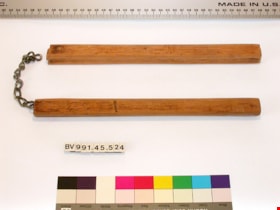

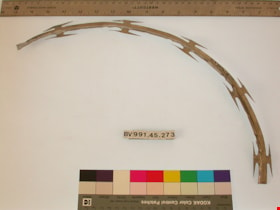
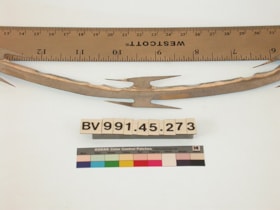
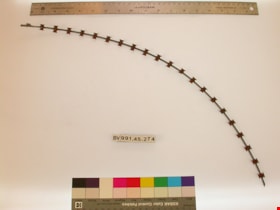
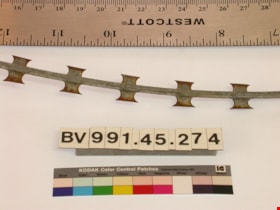
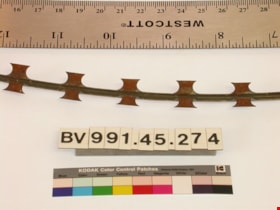
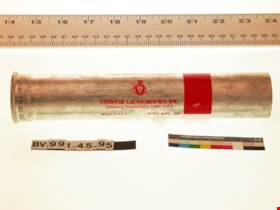
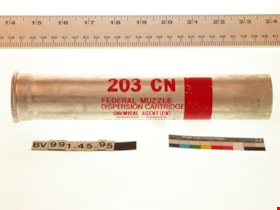
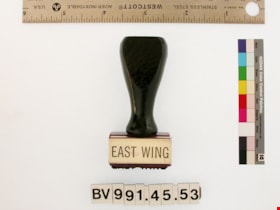


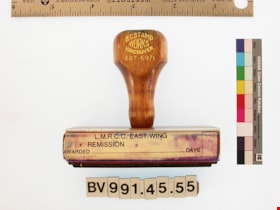
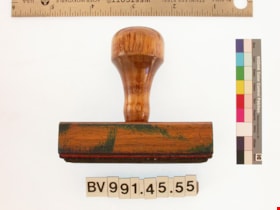
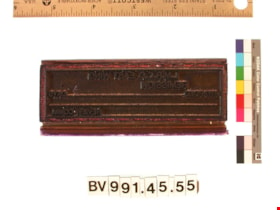
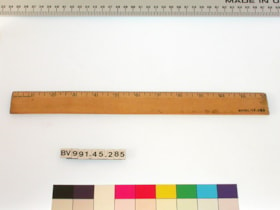
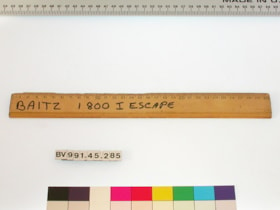
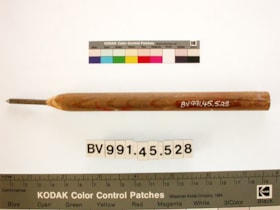
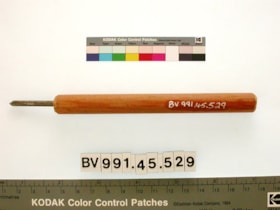
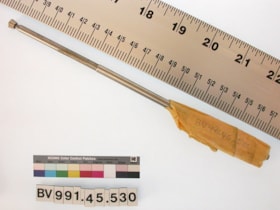
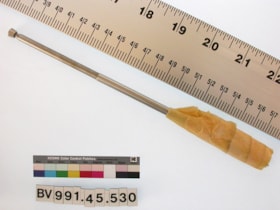
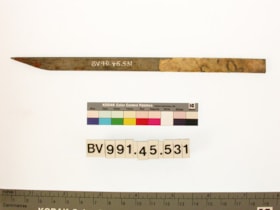
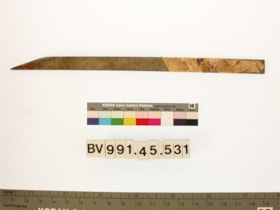
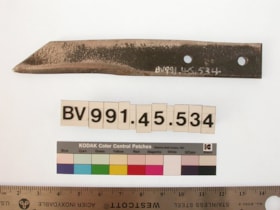
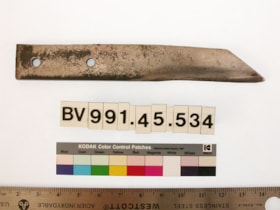
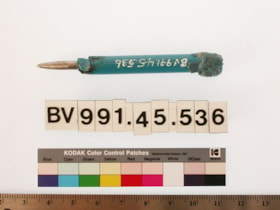
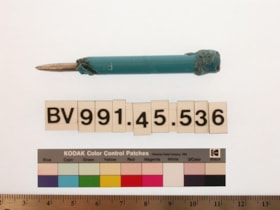
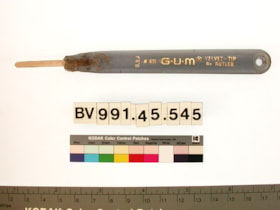
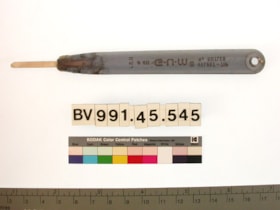
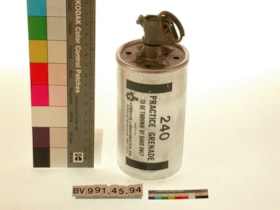
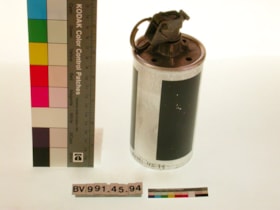
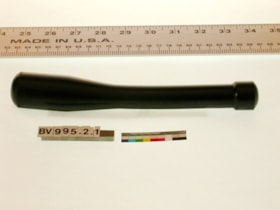
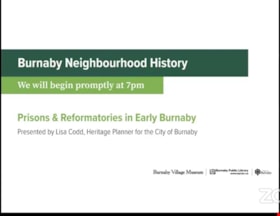
![Interview with Ellen and Bill Schwartz, [1969-2023] (interview content), interviewed 15 May 2023 thumbnail](/media/hpo/_Data/_BVM_Sound_Recordings/Oral_Histories/2023_0016_0006_001.jpg?width=280)
